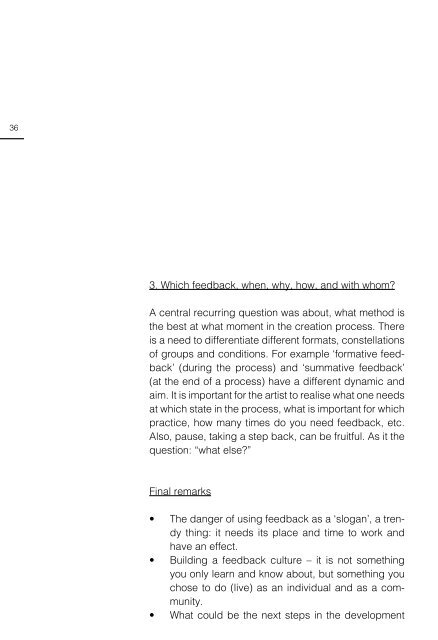Laboratory on Feedback in Artistic Processes 1
Feed-back is everywhere, and as a means to reflect, gather and share resources and methods on this expanding field the “Laboratory on Feedback in Artistic Processes” was initiated within the frame of “Teachback” – one of the modules of the project “Life Long Burning” 1 in collaboration with HZT Berlin and Uferstudios Berlin. The lab, held in January 2014, invited a group of people who shared an interest in the topic of feedback. Over the three days the group practiced, articulated and discussed different approaches, aims and experiences of existing methods of feedback. The idea was that a number of feedback-methods should be applied and tried out within the lab, as opposed to merely remaining on a theoretical discursive level. The document functions as a summarized report on the feedback lab; it collates the remarks from the invited observers, who were Inge Koks and Frederik Le Roy. Through a chronological order the document mainly gives a brief summary on each participant’s contribution with additional considerations and reflections on the proposed method or presentation. This short paper is written firstly as a documentation for those who partook in the lab and secondly, as a reference for those who will participate in a follow up format about feedback. IMPRINT Text by Sheena McGrandles, Nik Haffner, Inge Koks, Frederik Le Roy Photos, Layout and Editing Sheena McGrandles Editor: HZT Berlin, 2014
Feed-back is everywhere, and as a means to reflect, gather and share resources and methods on this expanding field the “Laboratory on Feedback in Artistic Processes” was initiated within the frame of “Teachback” – one of the modules of the project “Life Long Burning” 1 in collaboration with HZT Berlin and Uferstudios Berlin.
The lab, held in January 2014, invited a group of people who shared an interest in the topic of feedback. Over the three days the group practiced, articulated and discussed different approaches, aims and experiences of existing methods of feedback. The idea was that a number of feedback-methods should be applied and tried out within the lab, as opposed to merely remaining on a theoretical discursive level.
The document functions as a summarized report on the feedback lab; it collates the remarks from the invited observers, who were Inge Koks and Frederik Le Roy. Through a chronological order the document mainly gives a brief summary on each participant’s contribution with additional considerations and reflections on the proposed method or presentation. This short paper is written firstly as a documentation for those who partook in the lab and secondly, as a reference for those who will participate in a follow up format about feedback.
IMPRINT
Text by Sheena McGrandles, Nik Haffner, Inge Koks, Frederik Le Roy
Photos, Layout and Editing Sheena McGrandles
Editor: HZT Berlin, 2014
You also want an ePaper? Increase the reach of your titles
YUMPU automatically turns print PDFs into web optimized ePapers that Google loves.
of feedback?<br />
• Could it be <strong>in</strong>terest<strong>in</strong>g to th<strong>in</strong>k feedback as part of<br />
the art-work itself (process is the work)?<br />
• How could the audience/spectators be more <strong>in</strong>cluded/<strong>in</strong>volved<br />
<strong>in</strong> the feedback?<br />
• How could an exchange of feedback (methods)<br />
36 between different discipl<strong>in</strong>es and professi<strong>on</strong>s become<br />
37<br />
easier and more<br />
accessible?<br />
3. Which feedback, when, why, how, and with whom?<br />
A central recurr<strong>in</strong>g questi<strong>on</strong> was about, what method is<br />
the best at what moment <strong>in</strong> the creati<strong>on</strong> process. There<br />
is a need to differentiate different formats, c<strong>on</strong>stellati<strong>on</strong>s<br />
of groups and c<strong>on</strong>diti<strong>on</strong>s. For example ‘formative feedback’<br />
(dur<strong>in</strong>g the process) and ‘summative feedback’<br />
(at the end of a process) have a different dynamic and<br />
aim. It is important for the artist to realise what <strong>on</strong>e needs<br />
at which state <strong>in</strong> the process, what is important for which<br />
practice, how many times do you need feedback, etc.<br />
Also, pause, tak<strong>in</strong>g a step back, can be fruitful. As it the<br />
questi<strong>on</strong>: “what else?”<br />
F<strong>in</strong>al remarks<br />
• The danger of us<strong>in</strong>g feedback as a ‘slogan’, a trendy<br />
th<strong>in</strong>g: it needs its place and time to work and<br />
have an effect.<br />
• Build<strong>in</strong>g a feedback culture – it is not someth<strong>in</strong>g<br />
you <strong>on</strong>ly learn and know about, but someth<strong>in</strong>g you<br />
chose to do (live) as an <strong>in</strong>dividual and as a community.<br />
• What could be the next steps <strong>in</strong> the development


















